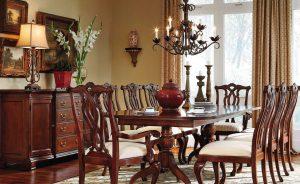 Do you have vintage pieces in your possession? Are there family heirlooms in your home that you wish to preserve? If so, read on. This article is here to show you how to successfully clean, display, and store the artifacts and antiques residing in your home.
Do you have vintage pieces in your possession? Are there family heirlooms in your home that you wish to preserve? If so, read on. This article is here to show you how to successfully clean, display, and store the artifacts and antiques residing in your home.
Cleaning
Cleaning antique furniture, often made of woods like mahogany, oak, pine, and walnut, correctly is crucial. Improper handling during cleanings can cause damage, so it is best to use gentle movements and wear gloves to protect the pieces from your skin’s natural oils. For regular cleanings, simply remove all the dust from the furniture’s surfaces with a dusting wand. If a simple dusting fails to restore shine, dip a cotton cloth into a diluted detergent and gently apply it to the wood. Use cotton swabs or cotton balls for hard to reach crevices. Then, rinse off the detergent with distilled water by blotting with a damp cloth or sponge. Make sure the damp cloth or sponge is not soaked, as you would not want to let water sit on the piece’s surface. Annually, finish the surface off with a wax coating. Buff the wax with a soft bristled brush after approximately 15 minutes. Avoid cleaning products and detergents containing silicone and Tung oil, as they can make the wood’s surface opaque, dull, and irreparable. If your piece has metal accents, be careful not to scrub away its patina, or oxidization, since this can depreciate the value of your item.
It is also important to properly clean other common household antiques, such as silver pieces, precious metals, and jewelry. Sterling silver pieces tend to tarnish if not cleaned regularly. The rate at which a piece tarnishes depends on how much humidity is in the air and how much of its composition is pure silver. Since sterling silver is not completely composed of pure silver, regular cleanings are a must. Silver pieces require a careful scrubbing with a cotton cloth, not a bristled brush. This is to avoid scratching the surface and diminishing the item’s value. First, don your gloves and dip your cloth into a silver cleaning solution. For more heavily tarnished items, you would want to avoid excess use of store-bought cleaners since their chemicals are highly corrosive. Instead, you can create your own effective solution with boiling water, baking soda, vinegar, and salt. Finish off the cleaning with a gentle polish for shine. The cleaning process for antique jewelry is very similar. With jewelry containing precious metals, especially gold and silver, be careful of their malleability and potential malformation. Rinse the item in lukewarm water, preferably while holding it over a bowl to avoid it slipping down the drain. Submerge it in a mild cleaning solution for 10-20 minutes. Gold pieces are better cleaned in solutions of water and very little ammonia; silver pairs best with water and baking soda solutions; pearls prefer natural oils; and gemstones do well in solutions of hot water and ammonia. Gently scrub away the loosened grime with a cotton cloth, swab, or ball. Rinse away the solution with lukewarm water and dry the piece with a fresh cloth.
When it comes to cleaning vintage books, paintings, and textiles, a regular dusting is always the first step. The stagnant nature of these pieces leaves them more susceptible to dust bunnies and dust mites. Book covers are prone to catch dirt and dust, so use a cotton cloth or soft bristled paint brush to clean them. Grasp the book tightly to avoid dust creeping into the pages, dust the opposite direction of the spine, and make sure to wipe the dust from the shelf or podium in which the book resides. Paintings require a similar cleaning method; except, make sure to dust exclusively using a soft bristled brush. Textiles, linens, and other antique fabrics are dusted via light shaking. They then require an overnight pre-soak. Soaking in lukewarm water helps to begin the dirt and excess dust removal process while keeping the colors from bleeding. If the fabrics are yellowed or stained, add OxiClean or another bleach-free solution to the water. After the pre-soak, rinse in cold water and transfer the item to a basin of phosphate-free soapy water. Gently scrub the fabrics with your hands and rinse with cool water once finished. Spread out the fabric upon an even and flat surface to dry. Depending on the fragility of the fabric, if you choose to iron the item, place a thick cotton towel between the fabric and the iron.
Proper Handling and Display
Having such beautiful pieces in your home can lead to the question: how should you properly handle and display these items? Should you wistfully appreciate these pieces from afar, or should you make practical use of them knowing it can potentially shorten their lifespan? If you do choose to display these items, remember that placement is crucial. To keep out of the way of kids and pets, consider mounting these pieces on walls, high shelves, or behind glass. In addition, keep these pieces away from direct sunlight and unstable temperatures, especially since photographs, paintings, and documents can become brittle and crack in excessive heat. Living in Tallahassee, heat and humidity levels can range drastically from day to day. Therefore, try to keep a stable internal temperature inside your home (between 65-75℉) and avoid displays near windows, as rainy days can lead to excessive moisture and water damage.
If you choose to make practical use of your antiques, keep the following in mind. For wooden furniture, protect their surfaces with tablecloths and coasters, avoid heavy stacking, and clean regularly. Handle books with clean hands, and remove a book from its post by grasping both of its sides instead of pulling at the spine. Avoid forcing the spine to lie open at a flat angle. Instead support the edges to decrease the severity of the angle. For textiles, linens, and other fabrics, avoid exposing them to strong scents and odors, such as perfumes, oils, and smoke. Avoid sharp corners or jewelry that could snag or catch the fabric. If the piece is adorning a dining table, temporarily and loosely fold up the piece during meals to protect it from food and drink.
Storage
For those antiques that are too precious to display or handle, it may be necessary to store them. Rather than storing these pieces in cardboard boxes, which are too easily susceptible to moisture absorption and bug penetration, understand that different items require different methods of packaging. For example, seal books and documents in airtight plastic bags to avoid lice and moths. Seal linens and fabrics in these airtight bags as well. Although it is better to loosely roll linens and fabrics to avoid creasing and tension, if you must fold them, avoid sharp folds by padding the folds with old sheets. For rugs and tapestries, roll them as you would fabrics, but remember to remove clasps or hanging devices, and refrain from wrapping them tightly around metal poles. Store jewelry in a household safe or a safety deposit box, and insure your expensive valuables. Keep delicate items and figurines thickly bundled in cloth. For larger pieces of furniture, cover them in plastic painter’s drop cloth or cloth sheets and carefully secure the cloths with tape. Avoid bubble wrapping wooden pieces for long periods of time since the plastic can constrict airflow and allow molds and bacteria to grow and damage your pieces. Overall, avoid bright lighting and excessive handling, store in a room cooled between 65-75℉, and be careful of your piece’s contact with adhesives when wrapping.
Artifacts and antiques are sacred treasures filled with stories and memories. If while assessing your items you realize they need more attention, consider contacting a professional to refinish your pieces to restore them to their former state. Although fragile, antiques’ preservation can be ensured with proper cleaning, display, and storage. This way, these precious pieces can secure the second life they deserve and live on in your family tree. ![]()
Andrea Lopez
Home & Yard Magazine




